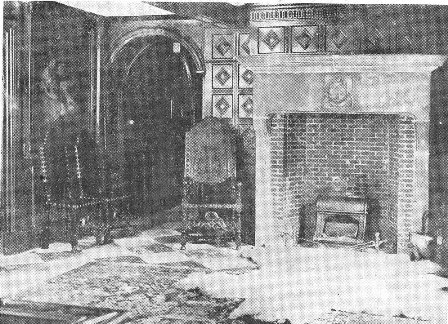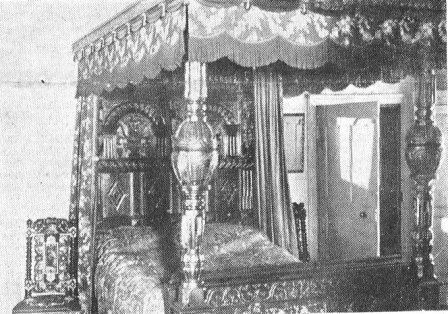A 1920s newspaper article
about Parrox Hall.

Around
Parrox Hall at Preesall the breeze is ever rustling. That is what strikes you as
you approach along the drive across the park to the long white
house.
The park
is dotted with noble isolated trees which cast heavy shadows when the days are
hot, so that the cattle love to rest beneath them.
The
trees are thick around the house. There is a clearance at the front only, which
enables you to gaze from the veranda across the pleasant green expanse to the
plantations that screen the main road. Otherwise the hall is
tree-embowered.
The wind
sings little sleepy songs in them in summer. In winter it hums and roars like a
huge Aeolian harp.
Pleasant
little paths thread through these woods in spring, winding between gorgeous
banks of bluebells and primroses. Up among the tree tops rooks build. Their
forefathers drove away the herons that used to live there many years ago, and
the exiled birds went to near Cockerham, where you find their descendants to
this day.
Sheltered by the woods, emerald lawns stretch behind the
house. Hoary trees stud them in places, and at their feet are mossy banks. If
you walk down a garden path you can turn and see the house shining white between
the trunks.
Part of
this pleasance is a garden, and in it you can never forget that a garden is,
indeed, the purest of human pleasures. It contains the essence of that
stateliness which only English gardens have. It is neat but not formal, and the
flowers are beautiful with a hazy, dreaming beauty, because their colours are so
soft.
It is
one of those gardens in which, you cannot think profanely. Roses, snapdragon,
marigolds, sweet peas, asters — imagine them set in a green lawn round a
sundial, with fruit trees here and there tempering the sunshine, and you have
some idea of Parrot Hall garden.
Family With History.
The
Elletson family, owners of many broad acres in Preesall and Pilling, live at
Parrox Hall. The family is an old one. It goes back to King John's stormy
times.
Belying
his nickname of " Lack-land," King John, when Earl of Moreton, granted this
manor to a man called de Hackenshaw, who evidently lived at Hackensall Hall, not
very far away.
That was
in 1190, and the grant of land made was " four oxgangs." An oxgang was as much
land as an ox could plough in a year.
The
estate eventually passed to Katherine ffyfe, who was the daughter of Dr.ffyfe,
physician to Charles II. There is still in existence a certificate appointing
him, which is dated June 26th, 1661. His descent was through Agnes de
Hackensall.
Katherine married John Elletson, of " Parrocks," about 1690,
and there we find an early evidence of the existence of Parrox Hall. It had
probably been built about the beginning of the 17th century, for the house is
typically Elizabethan.
How it
got its name presents a pretty problem to antiquarians. -
Some
think it is a corruption of " Par Rex "—" from the king." Others say it is a
form of the Anglo-Saxon " parruc," from which we get our modern "
paddock.''
In one
corner of the park there is a mound, perhaps twenty feet high, on which stands
the village war memorial, a somewhat squat and not very graceful
cross.
This
mound, which everybody in Preesall calls " the mount," is another thing which
has given rise to much speculation. The theory that it was an ancient " barrow,"
or tomb, is not supported by digging, for no remains have ever been
found.
It
certainly looks artificial, though in the dim past it may have been made as a
grandstand whence horse races in the park could be watched. Today you can stand
on it and watch people play tennis on the village club's courts. Time alters
fashions.
Gifts of a King.
A
notable descendant from John and Catherine was Roger Hope Elletson, who was
governor of Jamaica in 1766. He died in 1775, and left his property to his
widow. She married. the Duke of Buckingham and Chandos.
The
names of Roger, Hope, Chandos, and Fife recur again and again in the Elletson
family. The late Squire, who died a few years ,ago, was called Chandos, the
young Squire has the name of Hope, and his younger brother is called
Roger.
The
Governor of Jamaica was very friendly with the King of Portugal, and from the
monarch he received several beautiful oak chairs. You may still see them,
miracles of carving, in the main hall.
|

The Main
Hall, Parrox Hall c1928.
|
This
main hall is lovely. Heavy oak is all around, in beams, panelling, tables and
chairs. The big black and white diamond tiles of the floor set it off, and lead
your eyes naturally, to the great open fireplace with the family arms on the
cornice.
What a
room, with the fireplace full of blazing logs, for an eighteenth-century squire
to keep up Xmas!
From it
there swings up a staircase of sombre beauty, flanked by huge portraits, to an
exquisite landing.
Oak is
there again, and set on shelves over all the walls is a collection of Nanking
pottery over 200 years old, Shaped and coloured with all the graceful
imagination of Eastern potters and glaziers.
There is
an old, old clock, its ease figured with intricate skill, and by it a little
window looks out over the lawns. You leave that lauding with a feeling that a
perfect combination of weighty antiquity and sunlit colour has been
achieved.

This old canopied four-poster is dated
1614.
|
Turn
into a room on the left, and there you will see a wonderful bed. It is a
towering four-poster canopy of rich dark oak, and it dates from 1614. Three
carved figures of eccentric design look down on the sleeper.
The Panelled Dining Room.
The
dining room on the ground floor was panelled with modern oak in linenfold
pattern by the late squire. He was fond of his house, and was mightily pleased
with this when it was finished. He had reason to be. The Carolean and Jacobean
chairs set it off to perfection.
The
dining room was enlarged aboutten years ago. At the same
time a drawing room was added on the west side, so skilfully that perfect
harmony to the rest of the exterior was maintained.
To enter
it is to step from the beauty or the ancient to that of the modern. Its light
and airy decoration is delightful, and when you pass from its French windows to
the lawn it is hard to say which is the more charming.
If you
do so, and pass through the gardens, round the isolated billiards-room, the
greenhouses, and the stables to the coach-house entrance, you will find it
surmounted by a little turreted tower and a flagstaff.
The arch
into the coach-house is purely Norman in design, probably because the builders
did not disdain to plagiarize. To the right stands a massive yew-tree. It is
probably the last thing you will see before you leave, and it is fittingly so,
because, like all the rest of lovely Parrox Hall, it breathes the atmosphere of
calm old age and mellow beauty.
|